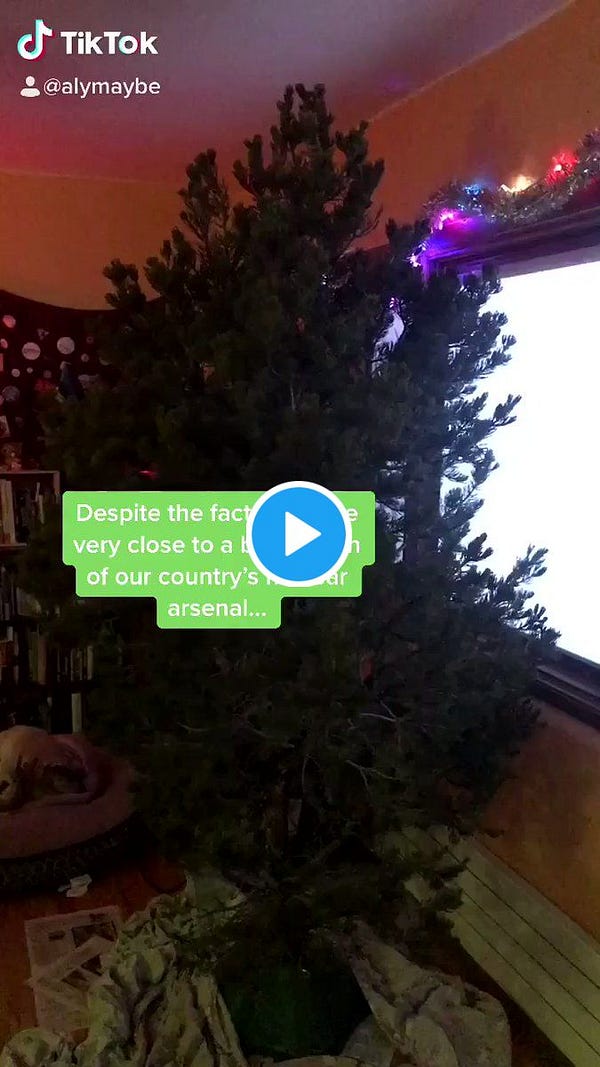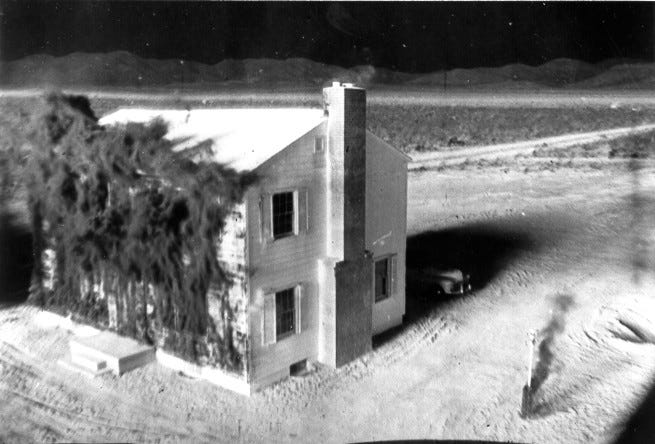Before we got our Christmas Tree this year, we had a conversation about nuclear war.
Alymay and I are, you might imagine, more prone to conversations about nukes than most folk, I think, though they are rarely logistical, or about the position of home furnishings. The Christmas Tree conversation had an explicitly practical side: sap explodes when rapidly heated. The tree we picked up, a fragrant Piñon Pine collected with a $5 permit from BLM-managed land, was especially sappy.
At a certain radius out from a given nuclear ground zero, beyond the immediate fireball and the greater blast zone, there’s a radius for thermal damage. It is this, in particular, that governed our placement of a Christmas Tree. Against a window, the tree can be brightly lit for the neighbors to see, and unobtrusive in a living room. The tree would also absorb more heat in a blast, as the full effect would come right through the window. If I put the tree in the window, in the event of the worst day of my life, I would have to deal with not just broken glass but a combusted tree, possibly one whose superheated sap exploded.


On the scale of “life changes from experiencing a nuclear war,” it is negligible. Within that specific day, in that specific moment, it is one further problem that could have been avoided with a slightly different living room arrangement.
Alymay and I were talking about Christmas Trees and nuclear attack because it is a recurring theme of Martin Pfeiffer’s public education work. Marty is a friend, and also a local anthropology PhD candidate focused on the nuclear enterprise as a thing people do. Upon arriving at a Christmas party years ago, back when there were Christmas parties, he remarked specifically on the placement of our tree, and what would happen to it in an attack.
We know this about Christmas trees and nuclear attacks because, as part of its nuclear testing in the 1950s, the United States built houses at nuclear testing grounds, filled them with mannequins and clutter, and recorded what happened. The house parts of these tests were carried out by Civil Defense, which was tasked with understanding what nuclear weapons do to the infrastructure of modern life. (My particular favorite non-holiday example of this is when banks figured out that paper records inside metal filing cabinets could survive a nuclear attack if it wasn’t a direct hit, ensuring that debt collection would survive into the post-apocalypse even if the specific debt collectors did not.)
As best I could find, Civil Defense never specifically tested a house with a Christmas Tree in the window during a nuclear test. It didn’t particularly need to. Civil Defense built houses for destruction in a 1953 test knowing the windows were already a weak point.
“To help in the prevention of fire, both houses were given white exterior finishes,” reads a modern pamphlet from the Nevada testing site, “and windows facing the explosion were equipped with aluminum Venetian blinds under the assumption that it would help to deflect much of the thermal energy generated from the explosion.”
Fire danger from dead trees, especially dry, dead trees, inside a house remains a topic of public safety campaign, though these days the warnings come from the US Consumer Safety Product Commission. (Nuclear warnings still exist, though they’re tucked away over at Ready.gov).
“Atomic Blast Creates Fire...Are You Prepared?,” a brochure published in 1951, specifically implores housewives to learn how to fight fires, “because the regular fire-fighting companies won’t be able to reach them.”
Maybe the most canonical example of nuclear home safety is “The House In The Middle,” a 1953 film. Using three identically built but differently decorated and cleaned houses, the test demonstrated how everything from paint color to paper clutter could change how a nuclear blast hit a house. That the safest house lined up to 1950s standards of placid suburban domesticity is hardly coincidental. In 1954, a paint lobbying group, branding itself the “National Clean Up – Paint Up – Fix Up Bureau,” released a color version of the film.
(That the suburbs are more immediately survivable in nuclear war than dense urban blocks is the kind of received wisdom that neglects what life looks like more than a month out from a war that functionally ends civilization as it was known. I generally think nuclear war stories do us a disservice when they end at the blast.)
Civil Defense, by design and decree, was explicitly tasked with ensuring the continuation of the nation through and after a nuclear war. That meant, most benevolently, ensuring the survival of people, too, but by nature of the task, it is impossible to save all of the people. Civil Defense is best remembered in popular culture through Bert the Turtle, the mascot which taught an entire generation to “Duck and Cover” in the event of a nuclear attack.
Duck and Cover is widely and rightly lampooned for the uselessness of the advice to anyone in the blast. It is a safety procedure impossible to execute in the fireball. In an absolute best case scenario, within the wider radius of “buildings collapse,” Duck and Cover allows some people to die in a position that makes their corpses easier to identify. On the edge of that range, when heat becomes the concern, Duck and Cover would save a nonzero number of lives in the attack. It is the kind of margin that matters abstractly, technocratically. A procedure that saves a handful of people out of every hundred who would have died otherwise yields returns at scale. Every survivor is one less corpse to tag, and one more set of eyes to identify corpses. Civil Defense very much carried about these numbers, because mitigating the worst effects of the worst possible war was its whole reason for being.
The inherited popular memory of Civil Defense is less a grim certainty to endure in the face of disaster, and more a grotesquely optimistic gloss on a nightmarish operation. It is easy, and compelling, to look at Civil Defense as the PR-friendly wing of the nuclear enterprise.
Yet I can’t help but, in this bloodiest stretch of the pandemic, long for a disaster management as thoughtful and thorough and holistic as Civil Defense promised the post-nuke world would be.
Video essayist Kyle Kallgren used the combination of the pandemic, and his return to the Fallout series of games, to inspire a 72-minute long commentary on “The Atomic Cafe”. The Atomic Cafe is a found footage marvel, piecing together official government films on winning nuclear war to highlight the absolute nightmare at the center of nuclear war planning. Kallgren places this juxtaposition in light of a similar state around COVID, where the malicious and cynical response by the federal (and most state) governments in the US has lead to a death toll that, by now, exceeds that of both atomic bombs the United States dropped in World War II.
Current estimates of the pandemic place the likely total before the present wave is contained at close to 1/2th a Megadeath, or a unit of corpses originally proposed to make it possible to talk about nuclear war in clear terms.
For all its myriad faults, Civil Defense believed in a government that wanted to govern, even and especially in the face of world-historical catastrophe. Scant little in the United States in 2020 has indicated that anyone in leadership in government shares this same belief.
Alymay and I agreed that, of the Decembers we have been alive and conscious, this is maybe the one most prone to nuclear war, even if the odds are still fairly low.
Using NukeMap, I set the likeliest ground zero location as the entrance to the Kirtland Munitions Storage Complex, an underground just south of Albuquerque which is estimated to contain between 1,000 and 2,000 nuclear warhead at all times, or quite possibly a greater number of nukes than the likely 1,270 nukes held by all countries that aren’t Russia or the United States. Burying the entrance to Kirtland with a nuclear blast would prevent those warheads making it out in a prolonged nuclear war. It is, I think, the single most likely target in the greater Albuquerque area.
I plugged both China’s Dong Feng 5 warhead and Russia’s Topol SS-25 warhead into the tool. Assuming one nuke on Kirtland’s munitions bunkers, we are in what NukeMap identifies as “Moderate blast damage radius,” almost certainly crushed in the rubble of our immediate postwar construction home. Add in another aimed closer to the center of population in Albuquerque, and everything is collapsed.
We ultimately rearranged our living room to fit the tree against the window. If the grim calculus proves correct, superheated sap from a tree against a window won’t even have time to cause us misery. In the meantime, the tree looks lovely.
We’ll enjoy it this year, as we have others in years past, as a promise for peace on earth.
I very much enjoy writing like this, and reader support is what lets me take it from a weird, time-intensive hobby into part of my patched-together freelance income. Paid subscribers can comment on all my entries here, and I’ve included a survey in my paid posts so I can better respond to what it is that subscribers actually want me to cover.
This specific issue of my newsletter, like the recent one on fallout shelters, leans heavily on the research of anthropologist Martin Pfeiffer, who is an invaluable scholar of everything weird about humans and the nuclear enterprise. If you liked this, I bet you’d love what Marty discovers and shares on his Patreon.
That’s all for this fortnight. Thank you all for reading, and if you’re in the mood for more newsletters, may I recommend checking out what we’re doing over at Discontents? Last week, we had a roundtable on how we, as writers, feel about Substack luring high-profile names from other publications, and I’d love to know how readers feel about it.






